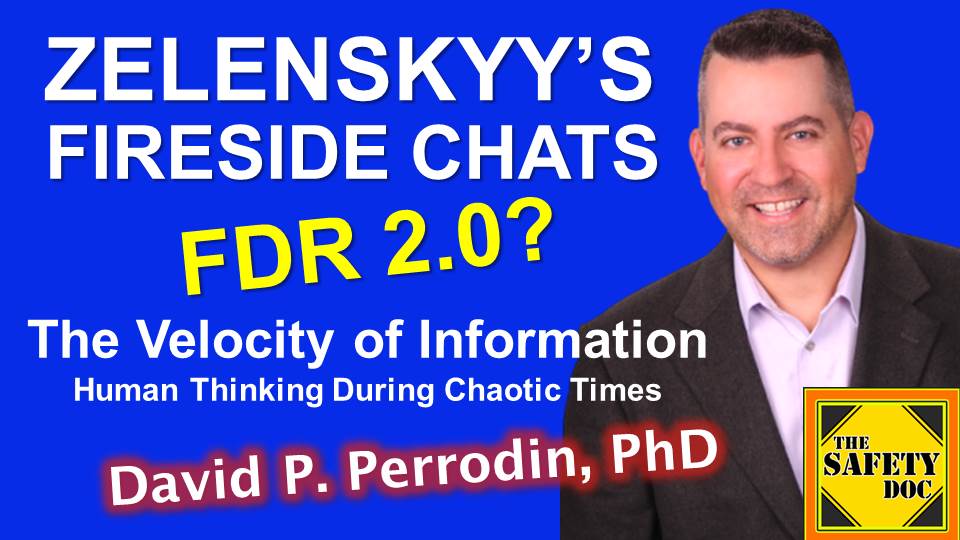Propaganda Clone | How Zelenskyy Modernized FDR’s Fireside Chat | Velocity of Information | SDP178
[Podcast] Between 1933 and 1944, President Franklin Delano Roosevelt delivered 31 evening radio addresses to ameliorate the fears and concerns of the American people as well as to inform them of the positions and actions taken by the U.S. Government. The addresses were both novel and sticking. Ranging from 11 to 44 minutes, these informal addresses resembled a pull-up-your-chair fireside chat atmosphere more than a formal projection originating behind an ordained podium. In this episode, Doc examines FDR’s fireside chats as he unpacked them (for messaging strategies during uncertain times) in his book, ‘The Velocity of Information – Human Thinking During Chaotic Times.’ Doc notes striking similarities to the style of presentation adopted by Ukraine President Volodymer Zelnskyy. Has Zelenskyy managed to modernize the propaganda formula that was a resounding success for FDR?

DIRECT LINK to MP3 of this Episode: https://tinyurl.com/SDP178-AUDIO
ROOSEVELT’S FIRESIDE CHATS – THE MAGIC IS THE MEDIUM. The following excerpts are from pages 96-98 of Dr. Perrodin’s book, The Velocity of Information – Human Thinking During Chaotic Times. “Franklin Delano Roosevelt’s presidency stands out not only for its duration but also the challenges he and America faced together from 1933 to 1945, from the Great Depression to World War II. The enormity of those two challenges, but especially the Depression, which welcomed FDR to office, forced him to the radio airwaves, early and often, in his now famous ‘fireside chats.’ The fireside chat was the creation of a White House aide. The idea was that beaming the president’s words, live, from his house to yours, unfiltered by time or editors, would allow unprecedented intimacy between the president and the public. “To many, the Great Depression confirmed what they had suspected all along: individuals no longer mattered in the new economic order (1).”
THE FIRST FIRESIDE CHAT. “The first fireside chat went out live just eight days after FDR’s inauguration, on March 12, 1933. “I want to talk for a few minutes with the people of the United States about banking,” he said at the start of the inaugural chat (2). The fireside chats were “the first media events—live, pre-planned, extraordinary broadcasts that riveted the attention of the nation—in American history,” writes history professor David Ryfe (3). “Roosevelt often used the ‘you’ form,” Ryfe continues “throughout the chats, he is concerned to ‘tell you,’ ‘interest you,’ ‘make it clear to you,’ and ‘make you understand (4).’” It was as if the president were speaking directly to each individual.
FEATURES OF THE FIRESIDE CHAT: FDR vs. ZELENSKYY. The appeal and enduring success of FDR’s fireside chats are attributable to several features, many of which are observed in the addresses of Ukraine President Zelenskyy amidst the 2022 military invasion-conflict by Russia. (A) Talk of the particulars and not mechanics: During the 1933 banking crisis, FDR didn’t speak at lengths explaining the banking holiday (closed banks), but rather the “fortitude” of Americans and the inconvenience and hardships they endured due to closed banks. Zelensky appeals to emotions, strength, and allegiance – even if he seemingly enrolls allies that are not formally allies, such as NATO. He avoids updates on the specifics of the conflict, but does not soften the devastation. (B) Short duration speeches: FDR’s fireside chats were between 11 and 44 minutes. This kept his message relevant without becoming rambling or redundant. During chaotic times, people have less tolerance and information-processing capacity for long-winded messaging. Zelensky’s addresses to Ukrainians mirror these figures. (C) Consistency: FDR spoke in plain language and without walk-up promotion. Zelenskyy is similar with his use of common language (and recognizable visuals) and his green henley shirts have not yielded to suits.
ZELENSKYY TALKING TO THE WORLD AS FDR ADDRESSED A NATION. As speeches are now just a smart-device away, Zelenskyy tends to address his countrymen through his addresses to the European Union, NATO, and Congress. And while the world tuned into FDR’s fireside chats, FDR was never addressing the world – he was talking to fellow Americans as the world listened in.
CITATIONS: (1) Ryfe, David Michael. “From Media Audience to Media Public: A Study of Letters Written in Reaction to FDR’s Fireside Chats.” Media, Culture and Society 23 (November 1, 2001): 767–781. doi: 10.1177/016344301023006005; (2) History.com Editors. “FDR Broadcasts First ‘Fireside Chat’ During the Great Depression.” History.com. November 24, 2009. history.com /this -day -in-history /fdr -gives -first -fireside -chat; (3) Ryfe, From Media Audience to Media Public, 767–781; (4) Ibid.
This is episode 178 of The Safety Doc Podcast published on 04-19-2022. This podcast and blog post represent the opinions of David P. Perrodin and his guests to the show. The content here is for informational purposes only. Please consult with your safety professional regarding the unique needs of yourself or your organization.
FOLLOW
- Watch this episode on “The Safety Doc” YouTube channel https://tinyurl.com/SDP178-VIDEO
- Listen to this episode on PodBean MP3 https://tinyurl.com/SDP178-AUDIO
- Apple Podcasts http://tinyurl.com/SafetyDocApplePodcasts
- SAFETY DOC WEBSITE & BLOG safetyphd.com
- Follow David & The Safety Doc Podcast on Twitter @SafetyPhD
- Email Dr. Perrodin [email protected]
Purchase Dr. Perrodin’s books
School of Errors – Rethinking School Safety in America
The Velocity of Information – Human Thinking During Chaotic Times
